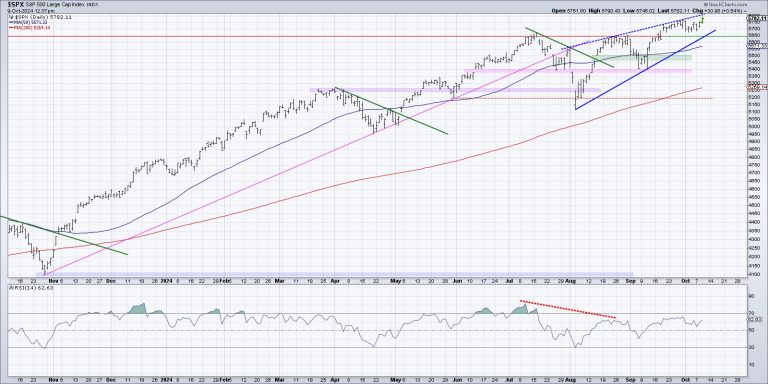Even though the S&P 500 index appears to be relentlessly pursuing new all-time highs, the traditional seasonal weakness in October leads me to be very focused on risk management right about now.
After my latest conversation with fellow StockCharts contributor Joe Rabil, and hearing his thoughts on risk management, I wanted to share some reflections on what risk management could mean for investors as we get into the meat of the 4th quarter.
Watch the S&P 500’s “Line in the Sand”
My general approach to technical analysis is determine the current trend, and then identify what level or signal would convince me that the trend had reversed. I call this the “line in the sand” technique, because you literally draw a line on the chart, and then don’t give the chart a second thought until and unless that line is violated.
For the S&P 500, that means I’m laser focused on the 5650 level. The July peak was right around this level, along with the subsequent peaks in mid and late August. The September breakout above 5650 was a key bullish move for the benchmark, and I would expect a break back below this price point could signal the end of the current bull run.
So until and unless we see the S&P 500 break below 5650, then the current bullish trend appears to be alive and well!
Breadth Indicators Could Provide an Early Warning
Now even if the S&P is still holding key support, plenty of individual names could break down before the benchmarks. In fact, this happens quite often at major market tops like 2007! Market breadth indicators are perhaps the best way to analyze and track this potential divergence, where individual stocks start to break down.
Here we can see the S&P 500 for the last 12 months along with the new 52-week highs minus new 52-week lows, the new highs and lows for the entire NYSE, and the new highs and lows for the S&P 500 members.
Note how all three of these data series topped out in mid-September, and have been steadily declining since then? A healthy bull market phase usually sees an expansion in new 52-week highs, as the leading names are powering to the upside. But in the last few weeks, we’re seeing a significant breadth divergence that tells me to be skeptical of the current uptrend phase.
Keep Your Position Size Manageable
In my latest podcast episode with fellow StockCharts contributor Joe Rabil, he shared some words of wisdom on how to think about risk management. I particularly appreciated his thoughts on position sizing, sharing that he usually risks about 1% of his portfolio on each new idea.
Options expert Price Headley once quipped, “If you’re having trouble sleeping at night, your position size is too big!” By being thoughtful and intentional about how much capital we risk on each new idea, we can minimize the pain in case some of the bearish signs we’re observing actually play out in the days and weeks ahead!
Mindless investors ignore risk management, focusing instead on how much they stand to gain if they’re proven right. Mindful investors recognize that they will often be wrong, and by managing risk, they can survive to invest another day.
RR#6,
Dave
PS- Ready to upgrade your investment process? Check out my free behavioral investing course!
David Keller, CMT
President and Chief Strategist
Sierra Alpha Research LLC
Disclaimer: This blog is for educational purposes only and should not be construed as financial advice. The ideas and strategies should never be used without first assessing your own personal and financial situation, or without consulting a financial professional.
The author does not have a position in mentioned securities at the time of publication. Any opinions expressed herein are solely those of the author and do not in any way represent the views or opinions of any other person or entity.

